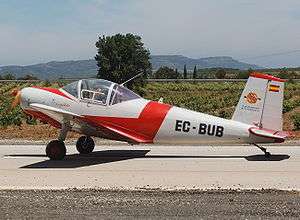AISA I-11
The I-11 was a two-seat civil utility aircraft manufactured in Spain in the 1950s. Originally designed by the Spanish aircraft company Iberavia, its first (of two) prototype flew on 16 July 1951. It was a low-wing monoplane of conventional configuration with fixed, tricycle undercarriage and a large, bubble canopy over the two side-by-side seats. Flight characteristics were found to be pleasing, but before plans could be made for mass production, Iberavia was acquired by AISA.
| I-11 | |
|---|---|
 | |
| Role | Two-seat general aviation aircraft |
| Manufacturer | Iberavia/AISA |
| First flight | 16 July 1951 |
| Number built | 208 |
| Variants | AISA I-115 |
The new management decided to continue with development, but made a few changes to the design, reducing the size of the canopy, and replacing the undercarriage with a taildragger arrangement. This configuration entered production in 1952 with an order from the Director General for Civil Aviation for 70 aircraft for use in Spain's aeroclubs. The Spanish Air Force then ordered 125 for use in training and liaison roles.
The Air Force then requested 200 aircraft built with the seats in tandem, which were designated I-115 by the manufacturers powered by a 112 kW (150 hp) ENMA Tigre inverted air-cooled engine.[1]
Variants
- I-11
- 2 prototypes by Iberavia, tricycle undercarriage
- I-11B
- Production examples by AISA
- AISA I-115
- Tandem-seat version.
Specifications (I-11B)
Data from Jane's All The World's Aircraft 1969–70 [2]
General characteristics
- Crew: 1
- Capacity: 1 passenger or trainee
- Length: 6.48 m (21 ft 3 in)
- Wingspan: 9.32 m (30 ft 7 in)
- Height: 1.91 m (6 ft 3 in)
- Wing area: 13.4 m2 (144 sq ft)
- Empty weight: 420 kg (926 lb)
- Gross weight: 669 kg (1,474 lb)
- Powerplant: 1 × Continental C90-12F Four-cyliner air-cooled horiztonally opposed piston engine, 67 kW (90 hp)
Performance
- Maximum speed: 201 km/h (125 mph, 109 kn)
- Cruise speed: 180 km/h (110 mph, 96 kn)
- Range: 640 km (400 mi, 350 nmi)
- Service ceiling: 4,700 m (15,400 ft)
- Rate of climb: 3.69 m/s (726 ft/min)
References
| Wikimedia Commons has media related to AISA I-11. |
- Bridgman 1956, pp. 211
- Taylor 1969, pp. 166–167
- Bridgman, Leonard (1956). Jane's All the World's Aircraft 1956–57. London: Jane's All the World's Aircraft Publishing Co. Ltd.CS1 maint: ref=harv (link)
- Taylor, John W.R., ed. (1969). Jane's All The World's Aircraft 1969-70. London: Jane's Yearbooks.CS1 maint: ref=harv (link)
- Taylor, Michael J. H. (1989). Jane's Encyclopedia of Aviation. London: Studio Editions. p. 50.
- Simpson, R. W. (1995). Airlife's General Aviation. Shrewsbury: Airlife Publishing. pp. 403–404.
- Fundació Aeronàutica Mallorquina website